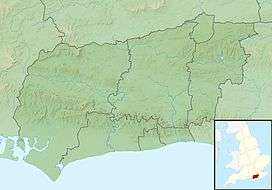Ouse Valley Viaduct
| Ouse Valley Viaduct | |
|---|---|
|
Northern end of Ouse Valley Viaduct | |
| Coordinates | 51°02′05″N 0°06′52″W / 51.03472°N 0.11444°WCoordinates: 51°02′05″N 0°06′52″W / 51.03472°N 0.11444°W |
| Carries | London and Brighton Railway |
| Crosses | River Ouse, Sussex |
| Locale | Between Haywards Heath and Balcombe |
| Maintained by | Network Rail |
| Heritage status | Grade II* listed building |
| Characteristics | |
| Pier construction | brick |
| Total length | 450 m (1,480 ft) |
| Width | 13 m (43 ft) |
| Height | 91 m (299 ft) |
| No. of spans | 37 |
| Rail characteristics | |
| No. of tracks | 2 |
| Track gauge | 1,435 mm (4 ft 8 1⁄2 in) |
| History | |
| Designer | John Urpeth Rastrick |
| Contracted lead designer | David Mocatta |
| Construction end | 1842 |
| Construction cost | £38,500 (1841) |
| Opened | July 1841 |
| Statistics | |
| Daily traffic | Brighton Main Line |
 Ouse Valley Viaduct Location in West Sussex | |
The Ouse Valley Viaduct (also called Balcombe Viaduct) carries the London-Brighton Railway Line over the River Ouse in Sussex. The crossing, which is north of Haywards Heath and south of Balcombe, was completed in 1841. The 11 million bricks needed for its construction were shipped up the Ouse River (via Newhaven and Lewes) from the Netherlands. It cost £38,500 to build.[1] (equivalent to about £3½ million in 2014[2])
Description
The viaduct is 96 feet (29 m) high and is carried on 37 semi-circular arches, each of 30 feet (9.1 m), surmounted by balustrades. Each pier contains a Jack arch with a semi-circular soffit to reduce the number of bricks required.[3] At each end of the abutment is an ornamental square open tower, the brickwork of which is faced with stone from Heddon Quarries near Newcastle-upon-Tyne.[4] The viaduct was designed by engineer for the line John Urpeth Rastrick in association with the architect of the London to Brighton railway, David Mocatta. It has been described as "probably the most elegant viaduct in Britain."[5]
History

Work to build the ornate viaduct began shortly after an Act of Parliament was passed in July 1837 giving the London & Brighton Railway company assent to construct the line to the south coast. More than 11 million bricks were shipped across the English Channel from the Netherlands to Newhaven and Lewes. Caen stone was also brought from Normandy in France. Building materials were transported to the construction site on barges up the Ouse River Navigation.
The Brighton main line was opened in two sections because completion was delayed by the need to construct some major earthworks. The viaduct was officially opened when the section between Norwood Junction - Haywards Heath was opened on 12 July 1841. Initially there was only one track in operation. The second line along with the viaduct's ornate stone parapets and pavilions were not completed until the following year.
By 1846, the viaduct had become part of the London, Brighton and South Coast Railway. In 1923 it became part of the Southern Railway network until nationalisation of the Big Four (British railway companies) in 1948.
Maintenance issues
Despite the structure's fine design, materials and architectural features, the viaduct has had an expensive and problematic history.
First, in the 1890s major repairs were made to the brickwork because engineers of the late Victorian era were concerned that the original lime mortar used in the viaduct's construction was inadequate. It was decided that this should be replaced with cement mortar. However, replacement facing brickwork and substandard mortar eventually caused its own failures prompting more expensive repairs. Second, as the parapets and pavilions were made from Caen stone, a high-quality limestone, they have been subject to heavy weathering. By 1956, the damage was extensive but the cost of refurbishment work was deemed too much by British Railways, the UK's nationalised rail operator.
Although by May 1983, the viaduct had been made a Grade II* listed building,[6] its eight pavilions were in such a poor condition that some of their roofs had fallen in and internal props were required to stop them collapsing further. English Heritage refused British Rails' request to demolish the buildings. The fabric of the structure continued to deteriorate over the next decade. Stonework had begun to fall away from the balustrades and parapets.
Starting in 1996 - with grants from West Sussex County Council, Railway Heritage Trust and English Heritage - the viaduct underwent a £6.5 million renovation over seen by Railtrack. Harder wearing limestone was imported from Bordeaux to ensure the closest match with the existing Caen stone in the balustrades and pavilions.[7] Some of the piers had to be reconstructed because of failures in the Victorian brickwork. The new bricks were handmade in a variety of sizes to suit the existing brickwork and set in a sand, cement and lime mortar. Throughout the work, one line always remained open while restoration was carried out on one side of the viaduct. The project, which was took more than three years, was completed in September 1999.
Around 110 trains-per-day use the Ouse Valley Viaduct on the Brighton Main Line.
References
| Wikimedia Commons has media related to Ouse Valley Viaduct. |
- ↑ Body, Geoffrey (1989). Railway of the Southern Region. Patrick Stephens. ISBN 1-85260-297-X. p.141.
- ↑ Inflation calculator
- ↑ Turner, John Howard (1977). The London Brighton and South Coast Railway 1 Origins and formation. Batsford. ISBN 0-7134-0275-X. p.124.
- ↑ Turner, p.124.
- ↑ Our Transport Heritage, http://www.transportheritage.com/find-heritage-locations.html?sobi2Task=sobi2Details&sobi2Id=84
- ↑ "Name: OUSE VALLEY RAILWAY VIADUCT THE OUSE VALLEY RAILWAY VIADUCT List entry Number: 1366101". Historic England. Retrieved 16 January 2016.
- ↑ "Trusting in Trusts: The Railway Heritage Trust: conservation and change". www.ihbc.org.uk. Retrieved 23 June 2017.